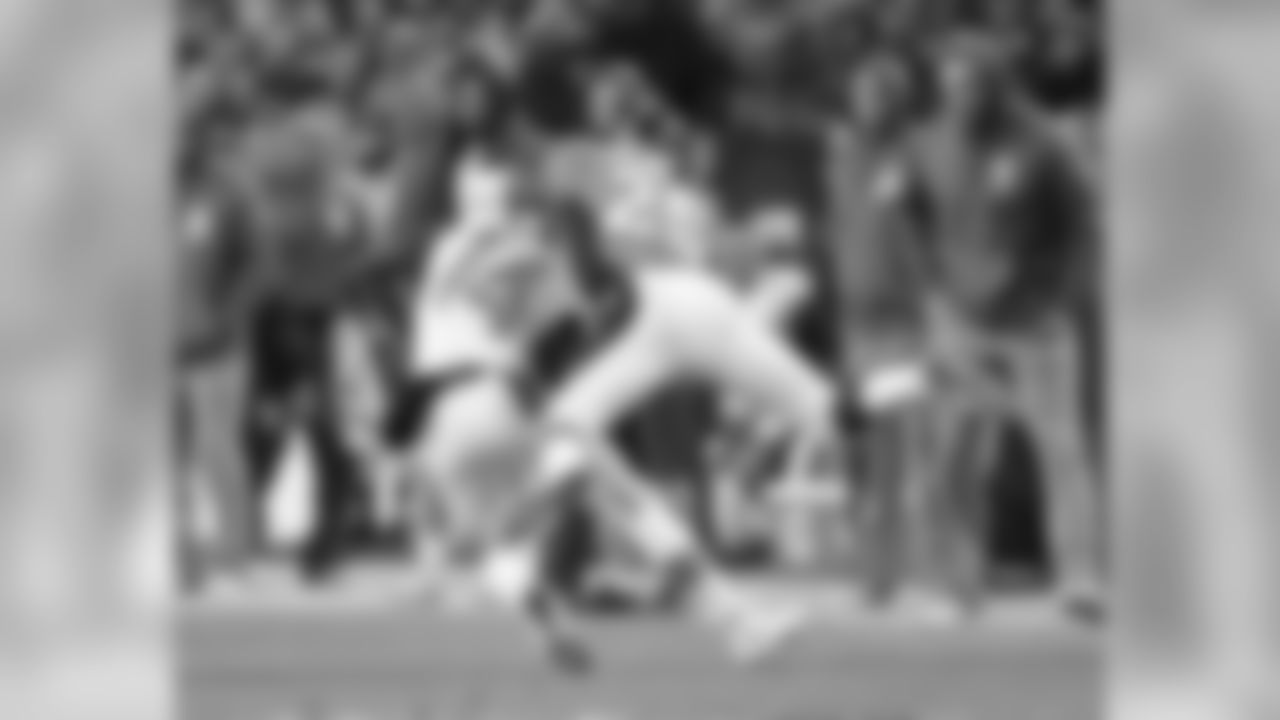**
DENVER -- **The message was clear, authoritative and established on the first series: the Broncos would run, and not be subtle about it, using a 6-foot-6, 310-pound offensive tackle as a tight end outside of one of the tackles.
Paul Cornick started, checked in with referee Jeff Triplette as an eligible receiver, and settled in for a busy day's work. He wasn't used exclusively; the Broncos went long stretches in three-wide receiver sets as the Broncos' 39-36 win over the Dolphins progressed.
But the tone was set by the first four plays -- all with Cornick reporting as eligible, all C.J. Anderson carries. He picked up 15 yards and a first down on that initial quartet of carries. By the end of the first quarter, the Broncos had 10 running plays, as many as they had last week at St. Louis (a total that included a kneeldown). By the end of the day, the Broncos would average six yards per carry when Cornick was on the field.
Check out snapshots of the best action from the second half of Sunday's win over the Dolphins.










































































The Broncos would tilt a bit more toward the pass at times; on their two-minute drill touchdown series at the end of the second quarter, all eight plays were passes, although a Will Montgomery penalty wiped an Anderson carry off the stat sheet. But they had the ability to do both with equal efficiency.
Balance isn't about simple run-pass ratio -- although the Broncos had 35 run plays and 36 pass plays Sunday. It's about being able to rely upon both.
"Obviously, we'd rather be running it than passing it," said Montgomery, speaking of the old maxim that offensive linemen would rather run and drive than protect the passer and retreat. "But we have a guy that can pass it pretty good, so to be effective in the long run, we need to do both, and we can do both."
The Broncos trailed by 11 points at the time of their quick march to Demaryius Thomas' 14-yard touchdown reception 12 seconds before halftime. They had the same deficit a quarter later, but with no need for the hurry-up, the Broncos ran, even with a two-score deficit. At a similar point in St. Louis, the Broncos went exclusively to the pass.
"It wasn't really panic time just yet, so we were just keeping on track with the game plan," said Montgomery.
And they ran on three of the first six plays of the series -- including a 20-yard, fourth-and-2 scamper at the end of the third quarter that slingshot the Broncos to the edge of the red zone.
Anderson gained 37 yards on those three carries, and finished the day with 167 on 27 attempts. Juwan Thompson pitched in another 33 yards on five carries. Their four carries of 20 or more yards matched the total in the Broncos' season to date.
And with outstanding pass protection, the offensive line completed a day marred only by three penalties for 35 yards.
The line was a big part of ensuring success in two of the three keys to the game, which we revisit here.
1. PROTECT PEYTON MANNING.
The offensive line kept the quarterback's pocket pristine for most of the game. Miami's fearsome pass rush finished with just one sack and one hit of Manning -- both coming when he dove to the ground to concede a sack on third-and-1 from the Miami 7-yard-line during the Broncos' first drive of the second half.
The Broncos' success on the ground prevented their pass rushers from being as aggressive as other teams were in recent weeks.
"I would think that would have thrown Miami off a little bit,'" said Manning. "They were probably expecting a few more passes and we were effective with the runs and it was definitely enough to win the game."
**
- DISRUPT MIAMI'S OFFENSIVE RHYTHM.**
Eventually, the Broncos used pressure to knock Ryan Tannehill off-kilter, forcing him out of the pocket and into throws that sailed through heavy traffic, culminating when Chris Harris Jr.'s defense led to a deflected pass for Jarvis Landry that T.J. Ward intercepted to set up the Broncos' final score.
The key, according to defensive tackle Terrance Knighton, was simplicity. In the first half, the Broncos changed their looks, inserted rookie Lamin Barrow as one of two nickel linebackers and tried to confuse Tannehill, who proceeded to dice up the defense, completing his last nine passes of the first half (his streak of consecutive completions eventually hit 12).
"They've got a complex offense. They do a lot of things, a lot of motions, a lot of disguise. They give a defense trouble with that," said Knighton.
"We just came in at halftime and said, 'You know what, we're going to get back to what we do,' and we went back to focusing on stopping the run. They did a good job of getting the personnels to put you in nickel defenses and then run the ball, and when you want to stop the run, they pass the ball. So we just got back to the basics and played basic defense and said 'You're going to have to beat us with our best players on the field.'"
After gaining 90 yards on 15 first-half carries, the Dolphins' ground output plummeted to seven yards on six carries in the second half.
3. ESTABLISH THE RUN.
This was clear on the first series, when the Broncos started Cornick and opened with four consecutive handoffs to C.J. Anderson for 15 yards. They finished that 12-play, 53-yard march with eight runs, which set them en route to a 201-yard performance that was the Broncos' best in 364 days -- and 12 more than their tally during the entire three-game road swing this month.
With the run as a weapon, the Broncos kept Miami's defense off-balance, neutralized their pass rush and delivered one of the best all-around offensive performances of recent years, with no punts after the first quarter.
Do you have a question for Andrew Mason? Ask it here and you might be in this week's Mailbag!





